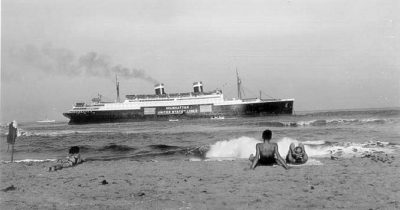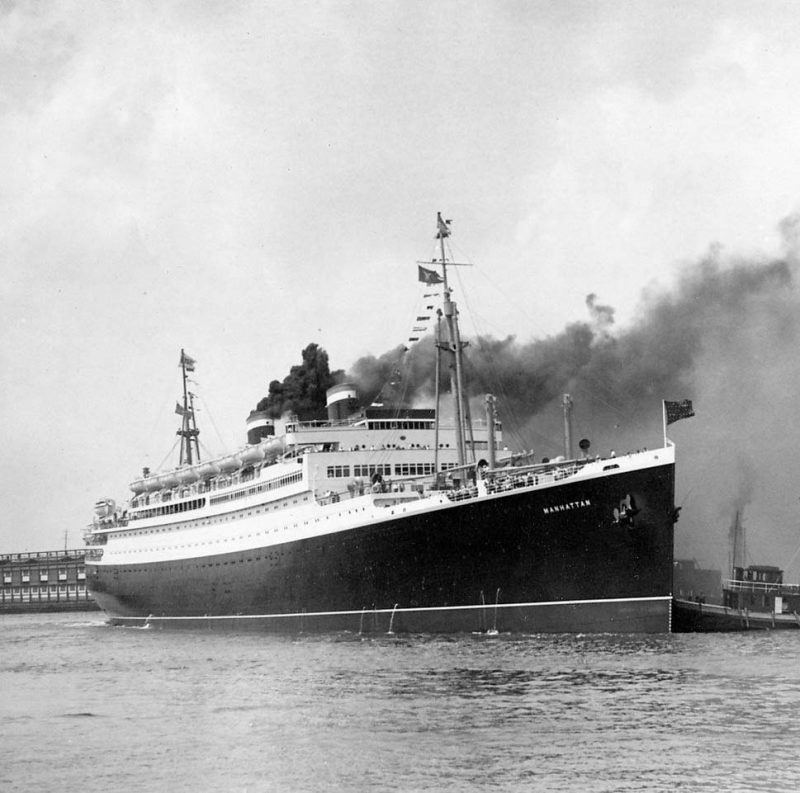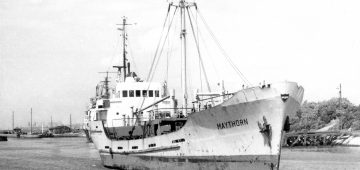United States Lines Cabin Class Liners

 The contract for these two Cabin Class passenger liners was given to the Camden (New Jersey) yard of the New York Shipbuilding Company in May 1930 at a time when unemployment in the shipbuilding industry was very high. They were financed by a 75% loan from the United States Government as they would be converted into auxiliary naval troopships fitted with six inch guns in times of war. The design plans needed to comply with three United States inspection authorities as well as the classification society of the American Bureau of Shipping. The latter gave these liners their highest classification for North Atlantic passenger and cargo service, and they did indeed offer very luxurious accommodation.
The contract for these two Cabin Class passenger liners was given to the Camden (New Jersey) yard of the New York Shipbuilding Company in May 1930 at a time when unemployment in the shipbuilding industry was very high. They were financed by a 75% loan from the United States Government as they would be converted into auxiliary naval troopships fitted with six inch guns in times of war. The design plans needed to comply with three United States inspection authorities as well as the classification society of the American Bureau of Shipping. The latter gave these liners their highest classification for North Atlantic passenger and cargo service, and they did indeed offer very luxurious accommodation.
Their classification as ‘Cabin Class’ was deliberate and interesting as the only other big passenger liner in the United States Lines service at this time was Leviathan, the former giant Vaterland of 54,282 grt built in 1914 by the Blohm & Voss yard at Hamburg with accommodation for 3,390 passengers in four classes and public rooms fitted out with crystal chandeliers and marble statuettes. Two other passenger and cargo-liners, President Harding (ex Lone Star State) and President Roosevelt (ex Peninsula State) built in 1921 as two of the sixteen ‘535’ class (535 feet in length), and seven cargo ships with ‘American’ prefixes to their names made up the fleet of United States Lines.
Manhattan and Washington had a pre-war gross tonnage of 24,300, which was an underestimate in terms of passenger liners of other flags, and they were re-measured in post-war years to give a figure of 29,600 grt. They had accommodation for 1,230 passengers in three classes, namely Cabin Class, Tourist Class and Third Class. ‘Cabin Class’ usually meant a cheaper and better sounding alternative to First Class, and in Manhattan and Washington, Cabin Class and Tourist Class avoided the more traditional names of First and Second Class to suit the more liberally minded temperament of United States citizens. The level of luxury of the pair was of a very high standard in ‘Cabin Class’, but below that of First Class on Leviathan, which because of the depressed nature of Transatlantic travel at this time, was forced to be withdrawn at New York in September 1934 and laid up, finally being broken up at Rosyth in 1938.
Design And Specification Of Manhattan And Washington
The designed overall length was 705.0 feet, moulded beam of 86.0 feet, depth to Promenade Deck of 75.0 feet and to ‘C’ deck of 47.0 feet, with a loaded draft of 30.0 feet. There were six cargo holds, three forward and three aft, of a total of 38,000 cubic feet with number four hold refrigerated, with oil fuel bunkers when full at 4,775 tonnes and fresh water capacity at 3,827 tonnes. A crew of 478 served 573 Cabin Class passengers, 461 Tourist Class passengers, and 196 Third Class passengers, giving when travelling fully booked a complement of 1,708 people onboard. The deadweight tonnage was 12,300 tonnes, and the displacement tonnage at maximum draft was 33,500 tonnes.

The profile of the pair featured a straight raked stem and bulbous bow, a combined fo’c’stle and bridge deck of 584.0 feet, two widely spaced tall funnels of elliptical shape, two tall masts and two pairs of posts with twenty cargo derricks, and a cruiser stern. The funnels were heightened by 12.6 feet after completion, and there were sixteen lifeboats of thirty feet in length on the Boat Deck and another six boats at the stern including two motor boats. The rudder was of the semi-balanced double plated type with a streamlined section, the frame being of cast steel and weighing 28 tonnes. The forged steel rudder post had a diameter of two feet, and was shaped at the foot to facilitate attachment to the rudder. The stern frame weighed 43 tonnes and was provided with two gudgeons to take the rudder pintles. The two lines of shafts to the twin propellers and the shaft brackets weighed in at a total weight of 73 tonnes.
There were a total of nine decks, working downwards they were Sun Deck, Boat Deck, Promenade Deck, ‘A’ deck, ‘B’ deck, ‘C’ deck, ‘D’ deck, ‘E’ deck and ‘F’ deck. Three decks (‘C’ deck, ‘D’ deck and ‘E’ deck) extended the full length of the ship, but ‘F’ deck was only worked forward of the machinery spaces and over number six hold and the aft peak, while ‘B’ deck of length 670 feet extended from the bow to a point corresponding to a point three feet aft of the rudder post. ‘A’ deck had a length of 520 feet, Promenade Deck was 405 feet in length, while the Boat Deck above had a length of 300 feet and the Sun Deck a length of 284 feet. There were eleven transverse bulkheads, the forward four extended to ‘B’ deck and the other seven to ‘C’ deck, and the ships were designed to reach port with four ‘midships compartments flooded. The collision bulkhead had extra protection in the form of strengthening at the cellular double bottom, which was of eight feet in height at that point, and extended without interruption from the fore peak to the aft peak. Seventeen compartments in the double bottom were for the carriage of fuel oil, fresh water, feed water for the boilers, and water ballast, with the latter also carried in the fore peak and aft peak.
Mail Room and Cabin Class Baggage Room were forward on ‘E’ deck, the Tourist Class Baggage Room was aft on ‘F’ deck. Storage rooms were provided at the forward ends of ‘D’, ‘E’ and ‘F’ decks, and below the steering gear compartment on ‘F’ deck. The refrigerated stores were located immediately above number four refrigerated hold. There were also fresh water tanks abreast of the aft number four and five holds and outboard of the shaft housings, and connected to each other across the ship by means of equalising tanks. Fifteen horizontally sliding electrically operated watertight doors were fitted in the bulkheads at ‘E’ deck level, and six vertically sliding doors in the machinery spaces. These could all be hand operated locally or controlled from the navigating bridge. The liners were framed on the transverse system, the spacing of the frames being three feet, tapering gradually to two feet in the fore and aft peaks. The requisite strength of the vessels also came from some longitudinal framing, to give two sturdily built liners.

Subscribe today to read the full article!
Simply click below to subscribe and not only read the full article instantly, but gain unparalleled access to the specialist magazine for shipping enthusiasts.







Comments
Sorry, comments are closed for this item